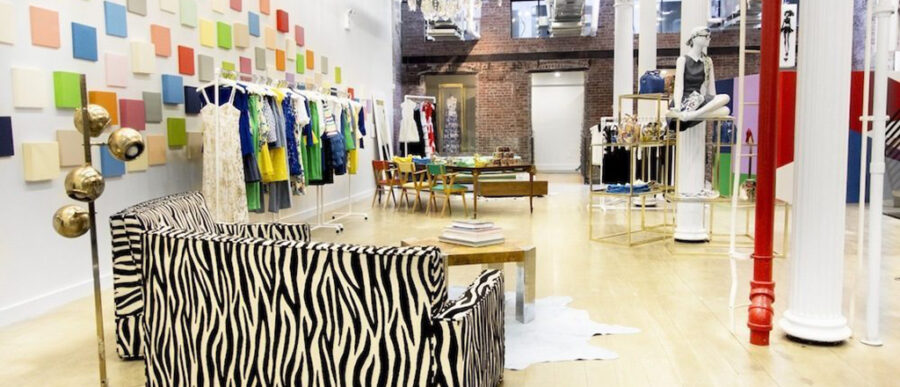If, as Mark Twain once proclaimed, “Clothes make the man,” do trousers then make the woman? They do if you’re Stacey Bendet.
Thirty-six-year-old Bendet is the founder and creative mind behind Alice + Olivia, a $150 million global women’s clothing company that is little more than a decade old. Bendet described the origin and rapid-growth of Alice + Olivia at the recent Retail and Consumer Goods Growth Summit, organized by Knowledge at Wharton, Wharton’s Jay H. Baker Retailing Center and Momentum Event Group.
The company’s origins, she said, can be traced to her quest for a perfect pair of pants. “Every girl has 100 pairs of jeans in her closet,” Bendet noted. “I wanted sexy novelty pants,” the kind that could be the focus of an outfit. When she couldn’t find any that fit the bill, Bendet created her own. When she was done, the former apparel company web designer said to herself, “Yes, girls will buy these. They fill a void in the market.”
Cut slim at the hips, her signature trousers create the coveted appearance of a lean body and elongated legs. Women did buy them — and then the question became what to pair them with. “It was a conscious evolution,” said Bendet, who serves on the board of the Baker center. “People in the stores said, ‘We need tops to go with the pants.’”
“I saw women paying $8,000 for a gown, and I said, ‘I can make that dress for $1,200.’”
That led to cashmere sweaters and eventually skirts. “Then I heard, ‘Everyone’s doing separates, but no one’s doing contemporary dresses that are chic and cute,’” Bendet noted. From there, it was a short leap from fabric to footwear. “At one point, I realized I was paying $1,000 for a pair of shoes, so I said, “Let’s do shoes that fit with our price-point,” she added.
The Alice + Olivia price-point is typically somewhere between $150 and $750 per item, with the exception of leather jackets (which can extend into four figures) and party dresses and gowns, which Bendet added to the collection. “I saw women paying $8,000 for a gown, and I said, ‘I can make that dress for $1,200,’” she said.
Although there’s a youthful vibe to Bendet’s clothes, the mother of two designs for all ages, whether it’s a dress for a girl’s bat mitzvah or prom or a mother’s gown for her daughter’s wedding. The Alice + Olivia collection is aimed at women who want high-fashion, couture-quality clothes but aren’t old enough or affluent enough to afford an $8,000 gown, Bendet noted.
Girls Just Wanna Have Fun
As Bendet introduced each new item to what is now a complete lifestyle brand, her focus was always on “thinking about what girls want and need.” When she says “girls,” Bendet really means women — women who enjoy classic, feminine, distinctively “girlie” kinds of clothes. She designs each collection with four types of women in mind.
“For instance, one might be the fashion editor who looks like she’s heading to the Conde Nast building or just stepped out of Vogue,” said Bendet. “The second would be the uptown girl who shops on Madison Avenue. The downtown girl would be wearing something short. And the fourth one is variable, the Bohemian or seasonal girl.”
While these four archetypes will change with each collection, Bendet said what doesn’t change is a focus on the qualities that fans expect from the brand — clothing that is young, fun, flirty, sophisticated and whimsical. “I’m pretty dictatorial about what is us and what is not us,” she noted. “I don’t design anything I wouldn’t wear myself.”
“So much of social media today sounds like advertising. It needs to be real. If it’s a staged photograph, it doesn’t do as well as if it’s me waving in the mirror.”
For example, AIR, a line of jersey and knit pieces, was born when Bendet became a mom and realized her clothes might need to change to fit the vagaries of parenting. “I decided perhaps that a silk ball gown isn’t practical at the park, but I still wanted my clothes to be cute and fun on the weekend. They also needed to transport well and not wrinkle, yet still feel like me.”
From Hemlines to the Bottom Line
There was no business plan when Alice + Olivia launched in 2002 and no plan for global expansion. At one point, Bendet recalled, her business partner, Andrew Rosen, the founder of men’s and women’s clothing line Theory, said, “Stace, look. You’re running a $75 to $80 million business like a $20 million one. You’ve got to grow up a bit.”
That’s when Bendet made a decision not to expand for a time. Although she noted that she prefers picking out fabrics to dealing with procedures and people, Bendet switched her focus to putting a level of management in place that would elevate Alice + Olivia to a $150 million business in three to five years. The strategy worked — last year, Alice + Olivia opened its first non-U.S. stores in Dubai, Kuwait, Tokyo and Hong Kong, bringing the number of free-standing boutiques — including those in New York, Connecticut and California — to 22. In addition, Bendet’s clothes are available in more than 800 select department and specialty stores worldwide, including Saks Fifth Avenue, Neiman Marcus, Bergdorf Goodman, Lane Crawford, Isetan, Hankyu, Harvey Nichols and Harrods, as well as online at aliceandolivia.com and prominent web retailers including Net-a-Porter and Shopbop.
“We need to do more with the technology for manufacturing. Three-D printing for clothing would be innovative.”
In terms of figuring out which pieces will sell, “some of it is evolution and some of it is stream of consciousness,” she said. “Street style influences couture design. As you get bigger and more global, you need reports from the field as to what’s happening in Asia and Europe.” Bendet also finds inspiration from trips she takes. “When I went to Istanbul, I bought a bunch of tablecloths and bedspreads, and then I used the look of those to make fabrics,” she noted.
‘We’re a Modern Brand’
While Alice + Olivia is a lifestyle brand to the women it outfits, for Bendet, it’s her life. She pointed out that she is involved not just in the design of the clothes, but also the whole process of production, the look of each boutique, the sales culture and how the brand is promoted.
“When a woman walks into the store, I want the clothes to fit perfectly, so she can walk out and wear it that night,” Bendet said, adding that a big chunk of her day is also spent on social media. “We’re a modern brand. We use social media so customers get insight into our world and where we are traveling. I fell in love with Instagram. I like it more than Twitter because it’s visual. We now have 370,000 followers.”
She also likes a new app called Storehouse, which allows users to combine text, photos and videos. And while fashion magazines are still important for building and promoting fashion reputations, Bendet said they are not the only voice anymore. “They’re still powerful, especially if [celebrities] are wearing something from our collection,” but bloggers can be big influencers as well if they have a large following, she noted.
Bendet handles the brand’s Instagram posts herself. “People will say, ‘It sounds so much like you.’ That’s because it is me,” she said. “So much of social media today sounds like advertising. It needs to be real. If it’s a staged photograph, it doesn’t do as well as if it’s me waving in the mirror. Followers want to see your world, spontaneously.”
Fans and followers get another look inside her world when they visit one of Alice + Olivia’s free-standing stores. While the architecture and the spaces themselves can vary greatly, she said, there are some signature elements that are common to each: molded wood, marble in the flooring, at least one mid-Century sofa and a “crazy chandelier.” Other variables can include design boards in the dressing rooms that feature fabrics and swatches similar to those that Bendet and her team use. An enlarged reproduction of one of her daughter’s drawings is displayed at another store.
To work at an Alice + Olivia store, Bendet noted, employees need to spread positivity and strength. “[Our] employees are proud, happy, excited, energetic. If not, they don’t work there.”
Looking ahead, Bendet said she would like expand the brand into eyewear and make-up but definitely not menswear. She would also like to see more innovation in clothing production. “It’s done the same way today as it was 100 years ago,” she said. “You still break needles when you sew. It’s still a laborious process. We need to do more with the technology for manufacturing. Three-D printing for clothing would be innovative.”



